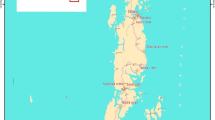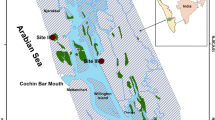Abstract
Mangrove stands in Puttalam lagoon and Dutch bay, two interconnected lagoons situated on the northwestern coast of Sri Lanka have been classified broadly into two groups, i.e., estuarine and island/mainland-fringing stands. Structural diversity of six mangrove stands, representing the two types was studied in terms of floristic composition, density, basal area, mean stand diameter, tree height, standing above-ground biomass and leaf-area index.Rhizophora mucronata andAvicennia marina were the dominant species. Higher mean stand diameters for the mangrove stands in Puttalam lagoon indicated greater maturity than the estuarine mangrove stands in Dutch bay. Nevertheless, estuarine stands in Dutch bay were structurally more complex (complexity indices 8.11–22.7) than the island/mainland-fringing mangrove stands (complexity indices 1.38–6.78). Higher number of species present in the estuarine mangrove stands is the major element that contributes to the higher values for the complexity indices for those stands. This appears to mask the contribution of stand-age to the complexity of a mangrove stand. Therefore complexity indices alone may not be used to explain adequately the structural diversity among mangrove stands.
Similar content being viewed by others
References
Amarasinghe, M. D. & W. K. T. Perera, 1984. A preliminary survey of the peripheral vegetation communities around Puttalam lagoon and Dutch bay, Sri Lanka. Proc. 41st Ann. Sess. SLAAS (abstract only).
Blasco, F., 1984. Taxonomic considerations of the mangrove species. In S. C. Snedaker & J. C. Snedaker (eds), The mangrove ecosystems: research methods. UNESCO, Paris; France: 81–90.
Cintron, G., A. E. Lugo, D. J. Pool & G. Morris, 1978. Mangroves of and environments in Puerto Rico and adjacent islands. Biotrop. 10: 110–121.
Cintron, G. & S. Y. Schaefer-Novelli, 1984. Methods for studying mangrove structure. In S. C. Snedaker & J. C. Snedaker (eds), The mangrove ecosystem: research methods. UNESCO, Paris; France: 91–113.
Cintron, G., A. E. Lugo & R. Martinez, 1985. Structural and functional properties of mangrove forests. In W. G. D'Arcy & A. M. D. Correa (eds), The botany and natural history of Panama: La botanica e historia natural de Panama IV series, Monographs in systematic botany, V 10, Missouri Botanical Gardens, St. Louis, Mo; USA: 53–56.
Dassanayake, M. D. & F. R. Fosberg, 1980. A revised handbook to the flora of Ceylon, Vol. I. Amarind Publishers, New Delhi; India: 508 pp.
Day, J. W. Jr., W. H. Corner, F. Ley-Lou, R. H. Day & A. M. Navarro, 1987. The productivity and composition of mangrove forests, Laguna de Terminos, Mexico. Aquat. Bot. 27: 267–284.
Holdridge, L. R., W. C. Grenko, W. H. Hatheway, T. Liang & J. Tosi, 1971. Forest environment in tropical life zones; a pilot study. Peragamon Press, New York: 747 pp.
Kanakaratne, M. D., W. K. T. Perera & B. U. S. Fernando, 1983. An attempt at determining the mangrove coverage in Puttalam lagoon, Dutch bay and Portugal bay, Sri Lanka, using remote sensing techniques. Proc. 4th Asian Conf. Remote Sensing, Colombo; Sri Lanka; P-15–1–9.
Kenneally, K. F., 1982. Mangroves of Western Australia. In B. F. Clough (ed.), Mangrove ecosystems in Australia: structure, function and management, Australian Institute of Marine Sciences; Australia: 95–110.
Lugo, A. E., G. Evink, M. M. Brinson, A. Broce & S. C. Snedaker, 1973. Diurnal rates of photosynthesis, respiration and transpiration in mangrove forests in south Florida. In: The role of mangrove ecosystems in the maintenance of environmental quality and high productivity of desirable fisheries. Centre for Aquatic Sciences.
Lugo, A. E. & S. C. Snedaker, 1975. Properties of a mangrove forest in southern Florida. In G. E. Walsh, S. C. Snedaker & H. J. Teas (eds), Proc. International Symposium on Biology and Management of Mangroves, IFAS, University of Florida; USA: 170–212.
Perera, W. K. T. & P. P. G. S. N. Siriwardena, 1982. Topography of Puttalam lagoon. J. Inland Fish. (Sri Lanka) 1: 97–104
Saenger, P., E. J. Hegerl & J. D. S. Davie, 1983. Global status of mangroves. IUCN Commission on Ecology, Pap. No. 3.
Watson, J. D., 1928. Mangrove forests of the Malay peninsula. Malaya Forest Records 6: 1–275.
Wells, A. G., 1982. Mangrove vegetation of northern Australia. In B. F. Clough (ed.), Mangrove ecosystems in Australia: Structure, Function and Management. Australian Institute of Marine Sciences: 57–78.
Author information
Authors and Affiliations
Rights and permissions
About this article
Cite this article
Amarasinghe, M.D., Balasubramaniam, S. Structural properties of two types of mangrove stands on the northwestern coast of Sri Lanka. Hydrobiologia 247, 17–27 (1992). https://doi.org/10.1007/BF00008201
Issue Date:
DOI: https://doi.org/10.1007/BF00008201




